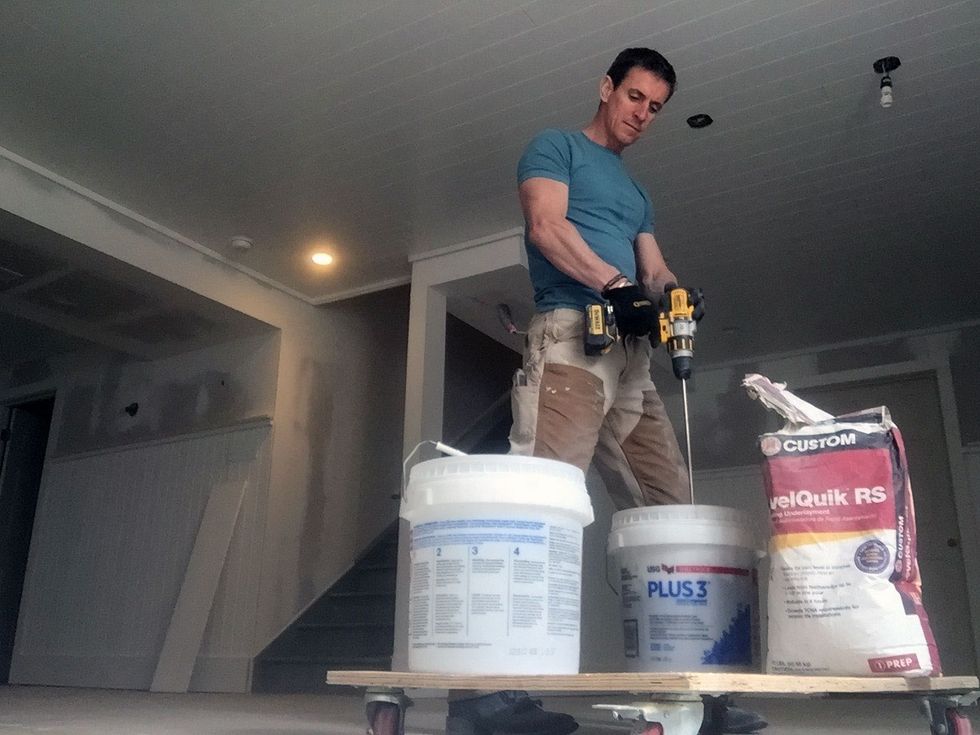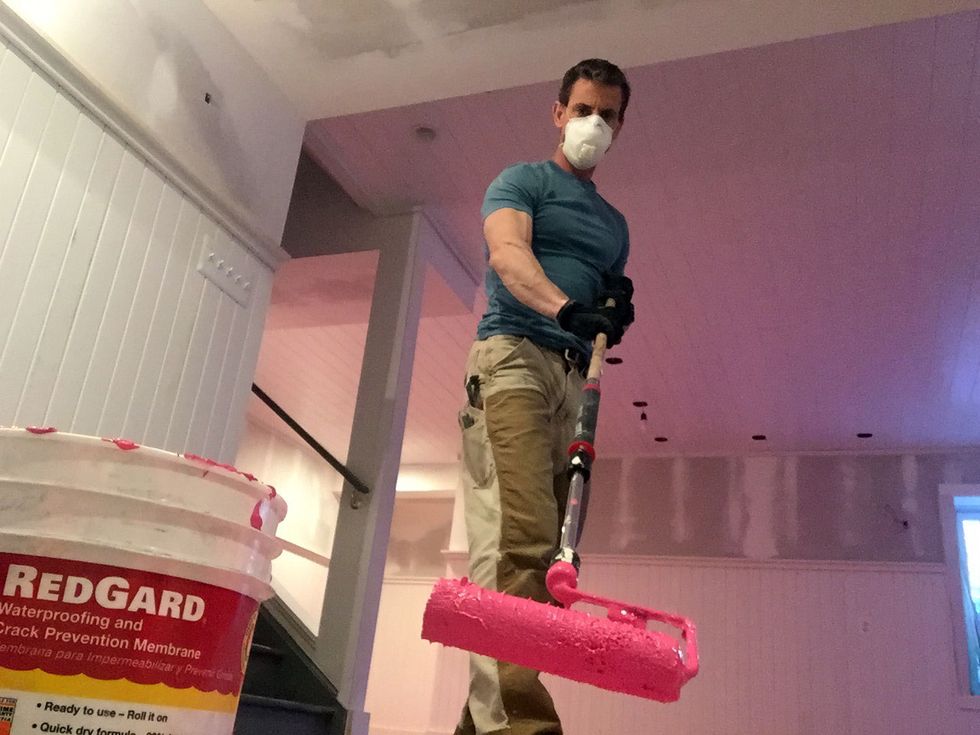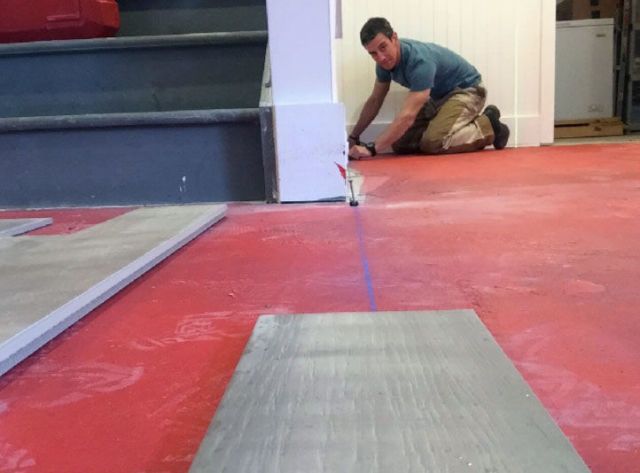Tips for Laying Top-Notch Tile
Setting your own tile can save a lot of money, and is a DIY project that anyone can take on. Mark Clement of MyFixItUpLife has laid a lot of tile, and shares his top tips for getting the best results. While tile is beautiful it’s also unforgiving: You can’t sand it, caulk it, or re-nail it. So it’s best to get the job done right the first time.
In most remodeling applications we use floor leveler to flatten the floor, not make it level. If your floor has deep pocks or bellies (some people call them ‘bird baths’) more than a 1/4-inch, mix up some floor leveler and pour it on. The key is getting the right viscosity: A little more viscous than water—but not much. It needs to be fluid enough to flow so gravity can draw it into a low spot. Strike off edges with a flat trowel.
Kneepads: They’re ugly, nearly always uncomfortable, and hot. They’re also 100 times better than kneeling on your bare knees all day.
Drill: With a 0-450 rpm in low gear, a cordless drill turns at just about the right speed to mix the mud without whipping it up.
Trowels: Use a Hyde Tools margin trowel. This $9 tool is gold for mixing small batches of material, scooping it from the bucket, and for spreading it around on the floor.Also use a 3/8 x 3/8-inch notched trowel. Large format tiles like a large format trowel. Use a flat edged trowel to screed a layer over the floor before combing it out. For plank tiles, comb the thinset perpendicular to the tile length.
Saw: A high-quality wet cutting tile saw is the only game in town. There’s no such thing as one that doesn’t spray water so set it up inside where it can get wet and you can clean it up without wrecking things.
Tile doesn’t move, but things around it do. Basement floors, walls, and counters, can shift. Use a waterproof crack isolation membrane called Red Gard. It’s similar to using rosin paper under a wood floor, RedGard is a ‘bond-break’. If the slab moves the RedGard flexes under the tile. It’s also waterproof and helps keep moisture and humidity from groundwater in check. It’s ideal for bathroom and wet service renovations too. To apply, simply roll on with a paint roller and let dry.
With a few exceptions, the first row of tiles should be the same width as the last row—no matter what the size of the room is.The bigger the room, the harder this is. And the more criteria there are, like notches around room features, the more you’ll need to think and plan ahead. Use a visible laser to cast a line, then measure the rest of the room, make small adjustments, and finally snap the final layout line in chalk.

Tile installation
Prepare the Surface
Make sure your surfaces are clean, smooth, and dry for best results. Take time to repair, patch, and level any damaged or uneven areas. Double check to make sure the surface is structurally sound and the area free of wax, soap scum, and grease.
Begin Your Layout
For an efficient layout, start by marking the center point of each of the walls in the room. Next, snap chalk lines between the center points of opposite walls to pinpoint the center of the room. Make any necessary adjustments to ensure that the intersection creates perfect squares.
Apply the Adhesive
As a general rule of thumb, be mindful to mix only enough of the adhesive to be used within 30 minutes. Using the flat side of the trowel type recommended on the adhesive package, spread a 1/4″ coat on the surface of one grid area without covering the guidelines.
Cut Tile as Needed
Start by marking carefully measured cuts-to-be with a pencil or felt-tip pen on the tile surface. You can use a tile cutter to achieve pinpoint straight or diagonal cuts. Make masterful curved cuts with a nipper, chipping away small pieces for best results.
Set Your Tile
Now that you’ve primed the surface, created the layout, applied the adhesive, and cut the tile, you are fully prepared for the actual installation of your tile.

Just Floored! Totally Unexpected DIY Flooring Alternatives
Belts Beneath Your Feet
Wait—don’t throw away that old belt! Arranged into large squares or tiles, used leather belts make a uniquely warm and soft flooring for home or office. Who would have thought?!
Sure Looks Like Salami
This sandwich meat–inspired flooring is the brainchild of Belgian artist Wim Delvoye. If you look closely at the center of each tile, you will see the distinct salami-patterned swirl replicated in the scanned, printed, and laminated images of luscious charcuterie…anyone else suddenly craving a sandwich?
More than a Pocketful of Pennies
Some people wish for a money tree out back, but why not a money floor? This project tops the cheap flooring ideas because it literally costs pennies to make. Glue copper coins in place, fill in with black grout, seal with clear coat, and you have a cent-sational floor that will wow your guests.
We’ll Drink to That
Reclaimed wood like that of whiskey barrels can cost less than the typical oak flooring. This particular flooring’s manufacturer, McKay, in the United Kingdom, carefully preserves the barrels’ branded markings from sherry, whiskey, and bourbon that make this lumber so distinctive.
Put a Cork in It
This one-of-a-kind floor was created from thousands of wine corks, laid horizontally in a wave pattern. If it sounds too daunting to drink your way to enough corks to cover the ground with this cheap flooring idea, try contacting local restaurants and bistros to ask for donations instead!

A Guide to Tiles – All You Need to Know About Tiles
If you’re thinking of buying tiles, you’ll find this link to a list of questions to ask before purchase very useful. It’ll ensure you’ve all the relevant information to hand, and are able to select the best tiles for your purpose.
Why Should I Use Tiles?
Practicality: Ceramic tiles are a versatile and down-to-earth home improvement technology. They’re easy to maintain, and help provide a water-proof barrier to your bathroom walls.
Durability: Do it once; do it right. Archaeologists have uncovered glazed tiles originally laid around 1,500BC. It proves that if you choose your tile wisely, there’s no reason your tiled area shouldn’t last for generations. Tiles are hardwearing, easily maintained, and not susceptible to fading from UV light.
Cleanliness: Tiles have long been recommended in preference to carpet to help combat dust allergies and asthma.
Design: Ceramic tiles should become an integral part of your home. Modern patterns and sizes will keep your home up-to-date with current trends, and careful selection will enhance and protect your home and add to its capital value.
Wall Tiles V Floor Tiles:
Tiles produced exclusively for walls are not intended to be load bearing. They are often lighter and thinner than floor tiles. The glazes used in the manufacture of a wall tile are also different, and are not designed to resist the abrasive forces from foot traffic. Wall tiles must only be used on walls.
Floor tiles are suitable for both floors and walls. It’s increasingly more popular to use them on bathroom walls, especially the rectangular ones. They’re up to 20% heavier than wall tiles, so it’s important that your tiler has verified the walls are sturdy enough to support their weight.
Porcelain Tiles V Ceramic Tiles:
Ceramic (or non-porcelain) tiles are usually produced by firing red or white clay in a kiln, and coating with a durable glaze which carries the colour and pattern. These tiles can be used on walls or floors. They are not as hard as porcelain, and can therefore be cut easier. The tiles can be used in areas of light to moderate traffic, such as domestic kitchen and bathroom floors, and any walls. They tend to absorb water, relatively speaking, which means they don’t have the frost-resistance of porcelain and therefore are not suitable for outdoor use.

Tile
A tile is a thin object usually square or rectangular in shape. Tile is a manufactured piece of hard-wearing material such as ceramic, stone, metal, baked clay, or even glass, generally used for covering roofs, floors, walls, or other objects such as tabletops. Alternatively, tile can sometimes refer to similar units made from lightweight materials such as perlite, wood, and mineral wool, typically used for wall and ceiling applications. In another sense, a tile is a construction tile or similar object, such as rectangular counters used in playing games (see tile-based game). The word is derived from the French word tuile, which is, in turn, from the Latin word tegula, meaning a roof tile composed of fired clay.
Tiles are often used to form wall and floor coverings, and can range from simple square tiles to complex or mosaics. Tiles are most often made of ceramic, typically glazed for internal uses and unglazed for roofing, but other materials are also commonly used, such as glass, cork, concrete and other composite materials, and stone. Tiling stone is typically marble, onyx, granite or slate. Thinner tiles can be used on walls than on floors, which require more durable surfaces that will resist impacts.
Decorative tile work and coloured brick
Decorative tilework or tile art should be distinguished from mosaic, where forms are made of great numbers of tiny irregularly positioned tesserae, each of a single color, usually of glass or sometimes ceramic or stone.
Ancient Middle East
The use of sun-dried bricks or adobe was the main method of building where river mud was found in abundance along the Tigris and Euphrates. Here the scarcity of stone may have been an incentive to develop the technology of making kiln-fired bricks to use as an alternative. To strengthen walls made from sun-dried bricks, fired bricks began to be used as an outer protective skin for more important buildings like temples, palaces, city walls and gates. Making fired bricks is an advanced pottery technique. Fired bricks are solid masses of clay heated in kilns to temperatures of between 950° and 1,150°C, and a well-made fired brick is an extremely durable object. Like sun-dried bricks they were made in wooden molds but for bricks with relief decorations special molds had to be made.
Ancient Indian subcontinent
Rooms with tiled floors made of clay decorated with geometric circular patterns have been discovered from the ancient remains of Kalibangan, Balakot and Ahladino